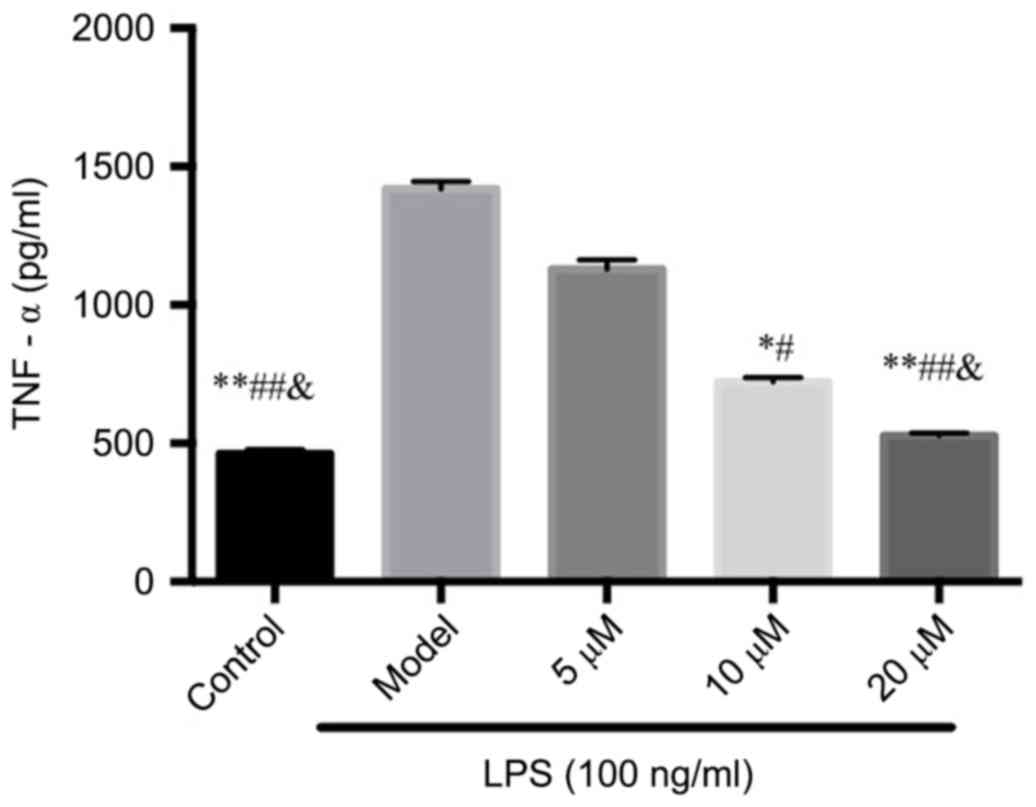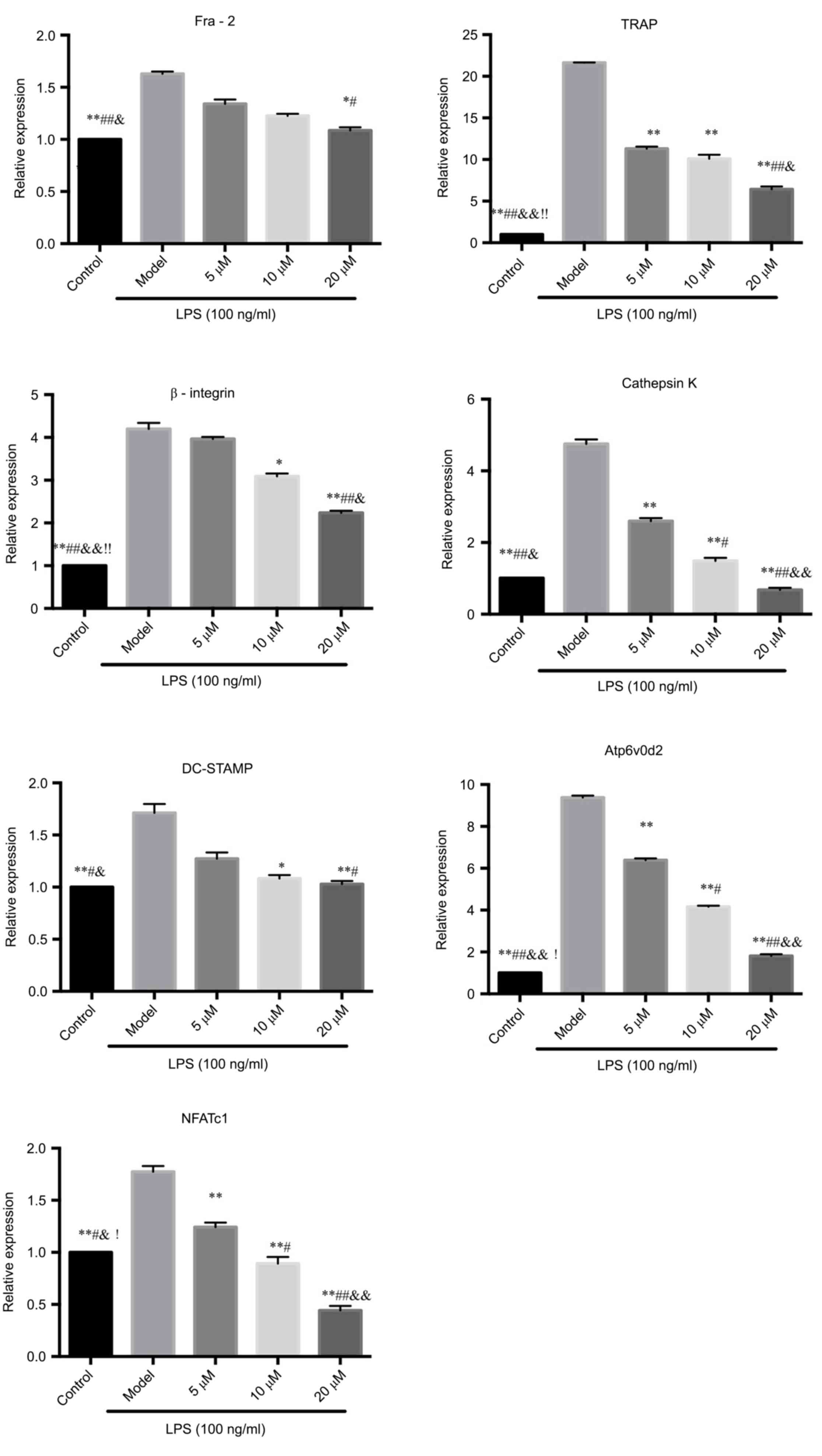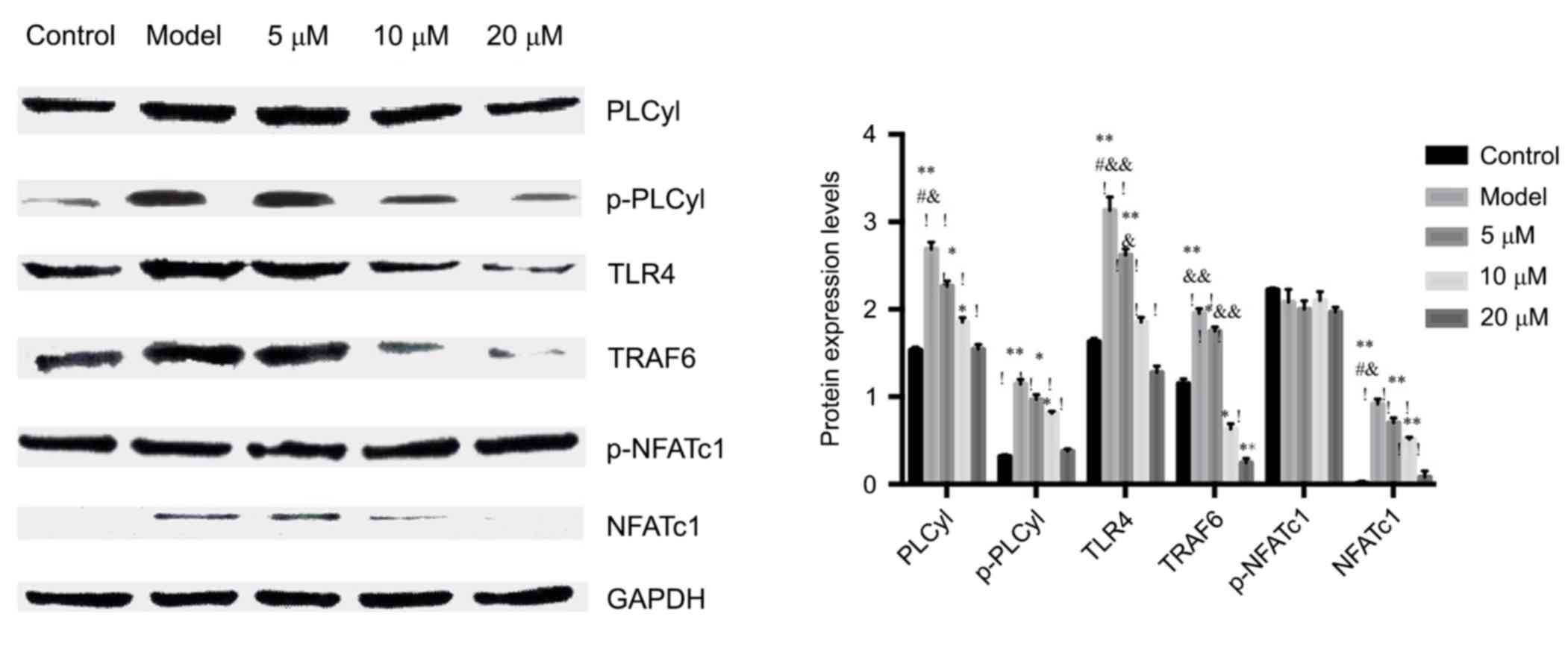The protective effect of berberine hydrochloride on LPS‑induced osteoclastogenesis through inhibiting TRAF6‑Ca2+‑calcineurin‑NFATcl signaling pathway
- Authors:
- Published online on: August 23, 2017 https://doi.org/10.3892/mmr.2017.7338
- Pages: 6228-6233
Abstract
Introduction
As a dynamic organ, the bone undergoes continuous resorption and generation process, of which the process is called remodeling. Under normal circumstances, there is a balance between osteoclast-mediated resorption and osteoblast-mediated formation, which maintains metabolism and homeostasis. However, the loss of balance may lead to skeletal diseases (1). Osteoclasts are the only cells that are responsible for bone resorption. Overexpression of osteoclasts leads to excessive bone resorption and bone destruction, thus causing osteoporosis, osteoarthritis and other common joint diseases (2–4).
Berberine hydrochloride, as an isoquinoline alkaloid, with molecular formula [C20H18NO4]+, also known as berberine, presents in many plants of the Berberidaceae families. Berberine can be precipitated in ether as yellow needle-like crystals, with melting point at 145°C, soluble in water, antibacterial to hemolytic Streptococcus, Staphylococcus aureus, Neisseria gonorrhoeae, and Freund's Shigella, and also can enhance leukocyte phagocytosis. Berberine hydrochloride has been widely used in the treatment of gastroenteritis, bacillary dysentery, pulmonary tuberculosis, scarlet fever, acute tonsillitis and respiratory infections. However, it has been reported neither whether the drug can affect osteoclastogenesis, nor osteoclast-associated bone destruction can be improved (5). Therefore, it is of certain significance to be investigated (6).
Materials and methods
RAW264.7 cell culture and the effect of berberine on lipopolysaccharide (LPS)-induced osteoclastogenesis
The 3rd generation passaged RAW264.7 cells (from Sun Yat-Sen University) were inoculated into 96-well plates at a density of 1×104/well and cultured in DMEM medium containing 10% FBS and 1% double antibody, 200 µl/well, and then put in an incubator at 37°C with 5% CO2. RAW264.7 cells were treated with LPS (100 ng/ml) except control group; normal saline was added to the model group, and Berberine hydrochloride (5, 10 and 20 µM; Manst Biological Technology Co., Ltd.) was added into the Drug group simultaneously. Each group was set with three multiple holes. Tartrate-resistant acid phosphatase (TRAP) staining was performed after 5 days' culture. The staining method was carried out according to the kit instructions. The cells were observed under an inverted microscope.
ELISA method to detect tumor necrosis factor-α (TNF-α) levels
After 24 h culture, the cells were put in the ELISA plate and added with diluted samples or standardized samples. The Control group holes were set at 100 µl. Biotinylated antibody were added into each hole at 50 µl, mixed, and sealed with closure plates. The cells were incubated at 37°C for 90 min, washed for 4 times, then added with streptavidin-HRP, with 100 µl per hole. Subsequently, the cells were incubated at 37°C for 30 min, and washed for 4 times. Color reagent TMB was added at 100 µl per hole. The cells were colored at 37°C for 10 min. Stop solution was added at 50 µl per hole. Absorbance at a wavelength of 450 nm was read by a microplate reader, and TNF-α density was calculated.
Quantitative polymerase chain reaction (PCR) assay to detect the mRNA expressions of fos-related antigen 2 (Fra-2), TRAP, β3-integrin, cathepsin K, dendritic cell-specific transmembrane protein (DC-STAMP), V-type proton ATPase subunit d 2 (Atp6v0d2) and NFATcl
The cells were incubated for 24 h and added with 1 ml TRIzol reagent, then agitated sufficiently. A total of 0.2 ml chloroform was added, mixed, agitated, and then the cells were ice-bathed standing for 5 min. The cells were centrifuged at 12,000 rpm for 20 min under 4°C. The supernatant was replaced with an equal volume of isopropanol, then ice-bathed standing for 5 min. The cells were centrifuged at 12,000 rpm for 20 min under 4°C. The supernatant was discarded and a total of 1 ml ethanol at 75% was added. The solution was agitated to dissolve the RNA thoroughly. The cells were centrifuged at 10,000 rpm for 5 min under 4°C. The supernatant was carefully removed, and the EP tube was turned upside down, then dried under room temperature for 15 min. A total of 20 µl RNase-free water was added to dissolve the precipitate, and 1 µl solution was suctioned into an Eppendorf, and the rest was stored in-70°C refrigerator. The 1 µl solution was diluted to 80 µl. OD260 and OD280 ratio was measured by a spectrophotometer, then total RNAs were calculated.
The cDNA synthesis and reverse transcription were carried out using the PrimeScript RT reagent kit according to the instructions, as follows: 5 times PrimeScript buffer 2 µl, PrimeScript RT Enzyme Mix 0.5 µl, Total RNA 2 µl, RNase Free dH2O 5 µl, and Total 10 µl. The reaction was carried out in water bath at 37°C for 15 min, and then at 85°C for 15 sec. After the reaction, an appropriate amount of cDNA was quantified by real-time PCR, and the remaining samples were stored under-20°C. Fluorescence real-time PCR was performed according to the instructions of the SYBR Premix Ex Taq™ II (Perfect Real Time) kit: SYBR Premix Ex Taq 12.5 µl, PCR Forward Primer 1 µl, PCR Reverse Primer 1 µl, DNA template 2 µl, d H2O 8.5 µl, and Total 25 µl. Fluorescence real-time PCR was performed as follows: Amplification curve: 5 min pre-denaturation at 95°C; 20 sec denaturation at 95°C; 30 sec annealing at 60°C; and 20 sec extending at 72°C. This stage was used for fluorescence signal acquisition, 40 cycles in total. The dissolution curve: 60°C-95°C, 0.5°C in each incremental, for 20 sec. This stage is for fluorescence signal acquisition, a total of 71 cycles. The size of PCR product was verified and a total of 10 µl was obtained to perform electrophoresis in 1% agar gel.
PCR primers were as follows: Fra-2, 5′-CCAACACGTAGTTTGAAGAC-3′ and 5′-TCCTGCCGCAGTTACACCG-3′; TRAP, 5′-TGACATCGAGCAGGTGAAAG-3′ and 5′-GAGTAGCAAGGAATGAGC-3′; β3-integrin, 5′-AGCGGACATTCTGGAAATG-3′ and 5′-TCGTTCATGCACTGCTGA-3′; cathepsin K, 5′-ACCGCACAACAGCAGCATT-3′ and 5′-AGCTTGCTGTGCTTCAGT-3′; DC-STAMP, 5′-AACTGTTGTGGCCTGAATC-3′ and 5′-CGGTAAATGCAGGCGTAT-3′; Atp6v0d2, 5′-CATCCCATCACCATCTTCC-3′ and 5′-TCACACATGACGAAGGCA-3′; NFATcl, 5′-TCCTCCATGAACAAACAG-3′ and 5′-AGACGTGGTTTAGGAATGCAG-3′; and GAPDH, 5′-AACTTTGGCATGTGGAAGG-3′ and 5′-ACACATTGGGGGTAGGAAC-3′.
Western blotting to detect the expressions of calcineurin in PLCyl, toll like receptor 4 (TLR4), TNF receptor associated factor 6 (TRAF6) and nuclear factor of activated T-cell 1 (NFATc1) signaling pathways
The above cells were cultured for 24 h, harvested, and washed with PBS twice. Each bottle was added with 400 µl of cell lysate, followed by 40 µl PMSF, agitated. The cells were placed on ice 10 min for sufficient lysis. After being repeatedly aspirated by a sterile syringe, the cells were put into an EP tube, which was ice-bathed for 30 min, and subsequently centrifuged at 12,000 × g for 15 min. After the supernatant was transferred to a new EP tube, 20 µl of protein sample buffer was added into each 100 µl tube, boiled for 5 min, mixed, and then stored under −80°C. The protein from the above samples was separated by 12% SDS-PAGE electrophoresis. The separated protein bands were transferred to a PVDF membrane by wet method and closed under room temperature for 1 h. Subsequently, the primary antibody was added (concentration 1:1,000) for 4°C overnight incubation. The primary antibody was discarded, and the secondary antibody (BA1026) was added (concentration 1:1,000) for 1 h incubation. The secondary antibody was abandoned, and color development and fixation were carried out after chemiluminescence. The expressions of calcineurin in PLCyl, TLR4, TRAF6 and NFATc1 signaling pathways were measured.
Confocal assay to detect the effect of berberine hydrochloride on intracellular Ca2+ concentration
After 24 h culture, the supernatant was discarded. The cells were washed with HESS, following this, HBSS containing 5Flou-3/AM and 0.05% Pluronic F127 was added. The cells were incubated for 30 min under 37°C. The supernatant was abandoned, and the cells were washed with HEPES buffer saline for 3 times. Subsequently, a sum of 2 ml HEPES buffer saline was added. At the excitation wavelength of 488 nm and the emission wavelength of 500–530 nm, the intracellular Ca2+ concentration was measured according to the intensity changes of FIuo-3/AM by using A1R laser scanning confocal microscopy.
Statistical methods
All data were expressed as mean ± SD. Comparisons between the two groups were carried out using the t-test, and multiple sets of data (>2) comparison using the one-way ANOVA, where P<0.05 denoted statistical significance. The data were analyzed by GraphPad Prism 5.0 (GraphPad Software Inc., San Diego, CA, USA).
Results
Effects of berberine on LPS-induced osteoclastogenesis
TRAP staining showed that RAW264.7 could be differentiated into mature osteoclasts after 5 days of LPS induction, while osteoclastogenesis was not seen in RAW264.7 cells in the negative Control group. The results showed that LPS-induced RAW264.7 cells' differentiation into osteoclasts can be significantly inhibited by Berberine hydrochloride of high concentration. See Fig. 1.
The inhibition of berberine on LPS-induced osteoclast TNF-α secretion
In the supernatant, LPS significantly induced TNF-α secretion, while the inhibition of TNF-α by berberine exhibited in a dose-dependent manner compared with that of the Control group, suggesting that berberine may inhibit osteoclastogenesis through inhibiting TNF-α production. See Fig. 2.
PCR assay to detect the mRNA expressions of Fra-2, TRAP, β3-integrin, cathepsin K, DC-STAMP, Atp6v0d2 and NFATcl
The mRNA expressions of Fra-2, TRAP, DC-STAMP and Atp6v0d2 in RAW264.7 cells induced by LPS were significantly inhibited by berberine hydrochloride, suggesting that berberine could inhibit LPS-induced osteoclasts-related gene expression, thereby inhibiting the differentiation of RAW264.7 cells to osteoclasts.
During the osteoclastogenesis, NFATcl was amplified and NFATcl mRNA was upregulated. The results showed that berberine can inhibit the increase of NFATcl gene expression induced by LPS in a concentration-dependent manner. The experimental results confirmed the hypothesis that the inhibition of osteoclastogenesis by berberine may be related to the activation of nuclear transcription factor NFATcl. See Fig. 3.
Western blot to detect the calcineurin expressions of PLCyl, p-PLCyl, TLR4, TRAF6 and NFATc1, p-NFATc1 signaling pathways
WB results showed that berberine hydrochloride significantly inhibited the expression of NFATcl in the nucleus. The results further confirmed the hypothesis that berberine inhibited the osteoclastogenesis possibly by inhibiting the activation of nuclear transcription factor NFATcl.
After stimulated by LPS, PLCyl was activated and increased intracellular Ca2+ concentration. The results showed that the activation of PLCyl, or the p-PLCyl protein, was significantly upregulated by LPS which was inhibited by berberine, suggesting that berberine could inhibit the activation of PLCyl, thereby inhibiting Ca2+ influx, which reduced intracellular Ca2+ concentration.
In order to further confirm the effect of berberine hydrochloride on LPS signal transduction pathway, the effect of berberine on the expression of LPS-induced TRAF6 protein was investigated. The expression of TRAF6 protein was significantly increased in RAW264.7 cells after LPS stimulation, but was significantly inhibited by berberine. The results were consistent with the detection of PCR. See Fig. 4.
Berberine to reduce the intracellular Ca2+ concentration
The intracellular Ca2+ concentration was measured by the Confocal technique. The results showed that LPS significantly increased intracellular Ca2+ concentration. However, berberine significantly reduced intracellular Ca2+ concentration, in particular, the high concentration group reduced intracellular Ca2+ concentration the most, even close to the normal group, suggesting that berberine hydrochloride can strongly inhibit Ca2+ influx. As shown in Fig. 5.
Discussion
‘Bone immunology’ is more and more a hot topic, in which the osteoclast is the only cell responsible for bone resorption. Under the category of ‘Bone immunology’, there are excessive activations of osteoclasts in degenerative diseases such as osteoporosis, inflammatory arthritis, and tumor-induced bone destruction (7). Activated osteoclasts can absorb bones, resulting in bone loss, causing fractures, reactive bone proliferation, and subsequent pain and disability. Drugs that whip the osteoclast differentiation can be applied to the treatment of osteoporosis, and in recent years expanding to the diseases such as tumor bone metastasis and rheumatoid arthritis (8).
LPS is a component of the G-cell wall, which can induce bone destruction through chronic infection. In vitro TRAP staining showed that berberine inhibited LPS-induced osteoclastogenesis. Studies have shown that inflammatory factors such as TNF-α, IL-1, and IL-6 can promote osteoclast-mediated bone resorption, posing a key regulatory factor in osteoclast activity (9,10). These inflammatory factors contribute to the formation of strong osteoclastogenesis stimulating molecules PGE2 by increasing the expression of COX-2 in osteoblasts and stromal cells. Increased TNF-α and other inflammatory factors are associated with the fracture of the femoral head in older women (11,12).
The present study found that berberine can reduce the TNF-α levels in LPS stimulated supernatant, suggesting that berberine may have the potential anti-inflammatory and anti-osteoclastogenesis effect by downregulating the production of TNF-α. In addition, it is found that berberine significantly inhibited the expression of TRAP gene in RAW264.7 cells. Inhibition of TNF-α activity may be the reason for the inhibition of TRAP activity.
Intracellular Ca2+ influx can activate calcineurin, which can de-phosphorylate the inactivated p-NFATcl, and promote NFATcl into the nucleus, thereby activating osteoclast-specific gene expression. The present study found that berberine inhibited calcineurin expression, thereby inhibiting cytoplasmic p-NFATcl de-phosphorylation and NFATcl nuclear translocation, indicating that drugs can inhibit the activation of NFATcl, and thus inhibit osteoclast-associated gene expression. And molecules such as DC-STAMP, Atp6v0d2 and Fra-2 are all related to osteoclastogenesis. During the osteoclastogenesis, the osteoclast precursors fuse into large multinucleated macrophages under the intervention of DC-STAMP and Atp6v0d2 (13,14).
Fra-2 can regulate the size and survival of osteoclasts (15). β3-integrin, cathepsin K and MMP-9 are necessary for osteoclasts to carry out bone resorption. Both β3-integrin and Cathepsin K played important roles in the bone resorption by mediating migration and adsorption of osteoclasts (16,17). Cathepsin K exhibited high expression in osteoclasts, making a key enzyme in degradation of organic bone matrix, thus facilitated the bone resorption of osteoclasts (18–20).
In conclusion, berberine hydrochloride may target through the TRAF6 and NFATcl, and inhibitosteoclastogenesis and bone destruction probably through inhibiting TRAF6-Ca2+-calcineurin-NFATcl signaling pathways.
References
|
Geusens P and Lems WF: Osteoimmimology and osteoporosis. Arthritis Res Ther. 13:2422011. View Article : Google Scholar : PubMed/NCBI | |
|
Deal C: Bone loss in rheumatoid arthritis: Systemic, periarticular, and focal. Curr Rheumatol Rep. 14:231–237. 2012. View Article : Google Scholar : PubMed/NCBI | |
|
McClung M, Harris ST, Miller PD, Bauer DC, Davison KS, Dian L, Hanley DA, Kendler DL, Yuen CK and Lewiecki EM: Bisphosphonate therapy for osteoporosis: Benefits, risks, and drug holiday. Am J Med. 126:13–20. 2013. View Article : Google Scholar : PubMed/NCBI | |
|
Schett G and Gravallese E: Bone erosion in rheumatoid arthritis: Mechanisms, diagnosis and treatmentJ. Nat Rev Rheumatol. 8:656–664. 2012. View Article : Google Scholar : PubMed/NCBI | |
|
Tao K, Xiao D, Weng J, Xiong A, Kang B and Zeng H: Berberine promotes bone marrow-derived mesenchymal stem cells osteogenic differentiation via canonical Wnt/β-catenin signaling pathway. Toxicol Lett. 240:68–80. 2016. View Article : Google Scholar : PubMed/NCBI | |
|
Banks L and Takayanagi H: Immunology and bone. J Biochem. 154:29–39. 2013. View Article : Google Scholar : PubMed/NCBI | |
|
Stickeler E and Fehm T: Targeted and osteo-oncologic: Treatment in early breast cancer: What is state of the art and what might become so within the next 5 years. Breast Care (Basel). 9:161–167. 2014. View Article : Google Scholar : PubMed/NCBI | |
|
D'Amico AV: US Food and drug administration approval of drugs for the treatment of prostate cancer: A new era has begun. J Clin Oncol. 32:362–364. 2014. View Article : Google Scholar : PubMed/NCBI | |
|
Manolagas SC and Jilka RL: Bone marrow, cytokines, and bone remodeling. Emerging insights into the pathophysiology of osteoporosis. N Engl J Med. 332:305–311. 1995. View Article : Google Scholar : PubMed/NCBI | |
|
Braun T and Schett G: Pathways for bone loss in inflammatory disease. Curr Osteoporos Rep. 10:101–108. 2012. View Article : Google Scholar : PubMed/NCBI | |
|
Okada Y, Lorenzo JA, Freeman AM, Tomita M, Morham SG, Raisz LG and Pilbeam CC: Prostaglandin G/H synthase-2 is required for maximal formation of osteoclast-like cells in cultur. J Clin Invest. 105:823–832. 2000. View Article : Google Scholar : PubMed/NCBI | |
|
Barbour KE, Boudreau R, Danielson ME, Youk AO, Wactawski-Wende J, Greep NC, LaCroix AZ, Jackson RD, Wallace RB, Bauer DC, et al: Inflammatory markeirs and the risk of hip fracture: The women's health initiative. J Bone Miner Res. 27:1167–1176. 2012. View Article : Google Scholar : PubMed/NCBI | |
|
Kim K, Lee SH, Ha Kim J, Choi Y and Kim N: NFATcl induces osteoclast fusion via up-regulation of Atp6v0d2 and the dendritic cell specific transmembrane protein (DC-STAMP). Mol Endocrinol. 22:H6–85. 2008. View Article : Google Scholar | |
|
Yagi M, Miyamoto T, Sawatani Y, Iwamoto K, Hosogane N, Fujita N, Morita K, Ninomiya K, Suzuki T, Miyamoto K, et al: DC-STAMP is essential for cell-cell fusion in osteoclasts and foreign body giant cells. J Exp Med. 202:345–351. 2005. View Article : Google Scholar : PubMed/NCBI | |
|
Bozec A, Bakiri L, Hoebertz A, Eferl R, Schilling AF, Komnenovic V, Scheuch H, Priemel M, Stewart CL, Amling M and Wagner EF: Osteoclast size is controlled by Fra-2 through LIF/LIF-receptor signalling and hypoxia. Nature. 454:221–225. 2008. View Article : Google Scholar : PubMed/NCBI | |
|
Song I, Kim R, Kim K, Jin HM, Youn BU and Kim N: Regulatory mechanism of NFATcl in RANKL induced osteoclast activation. FEBS Lett. 583:2435–2440. 2009. View Article : Google Scholar : PubMed/NCBI | |
|
Wei ZF, Tong B, Xia YF, Lu Q, Chou GX, Wang ZT and Dai Y: Norisoboldine suppresses osteoclast differentiation through preventing the accumulation of TRAF6-TAK1 complexes and activation of MAPKs/NF-κB/c-Fos/NFATc1 pathways. PLoS One. 8:e591712013. View Article : Google Scholar : PubMed/NCBI | |
|
Asagiri M and Takayanagi H: The molecular understanding of osteoclast differentiation. Bone. 40:251–264. 2007. View Article : Google Scholar : PubMed/NCBI | |
|
Costa AG, Cusano NE, Silva BC, Cremers S and Bilezikian JP: Cathepsin K: Its skeletal actions and role as a therapeutic target in osteoporosis. Nat Rev Rheumatol. 7:447–456. 2011. View Article : Google Scholar : PubMed/NCBI | |
|
Broadhead ML, Clark JC, Dass CR, Choong PF and Myers DE: The apeutic targeting of osteoclast fimction and pathways. Expert Opin Ther Targets. 15:169–181. 2011. View Article : Google Scholar : PubMed/NCBI |














